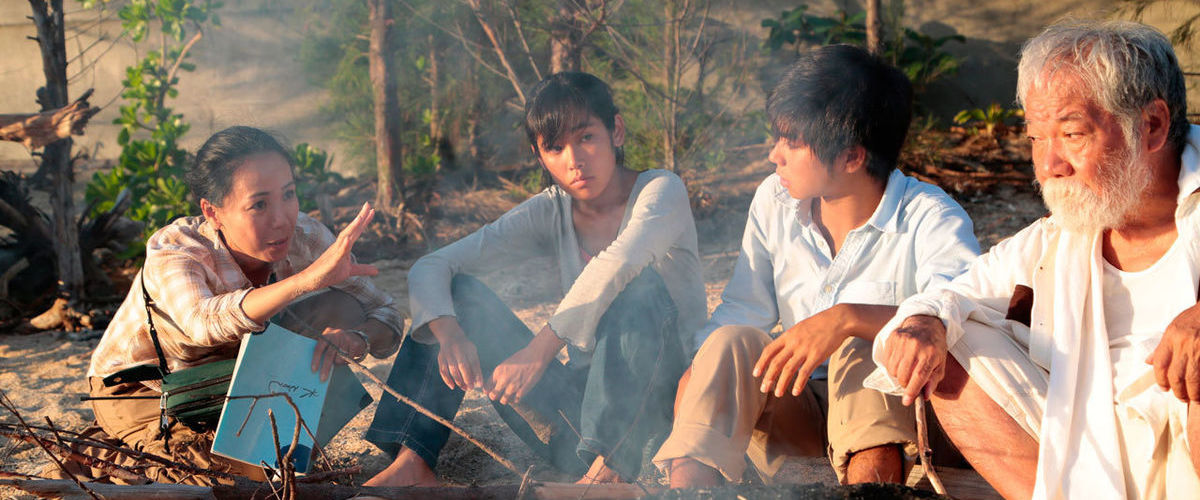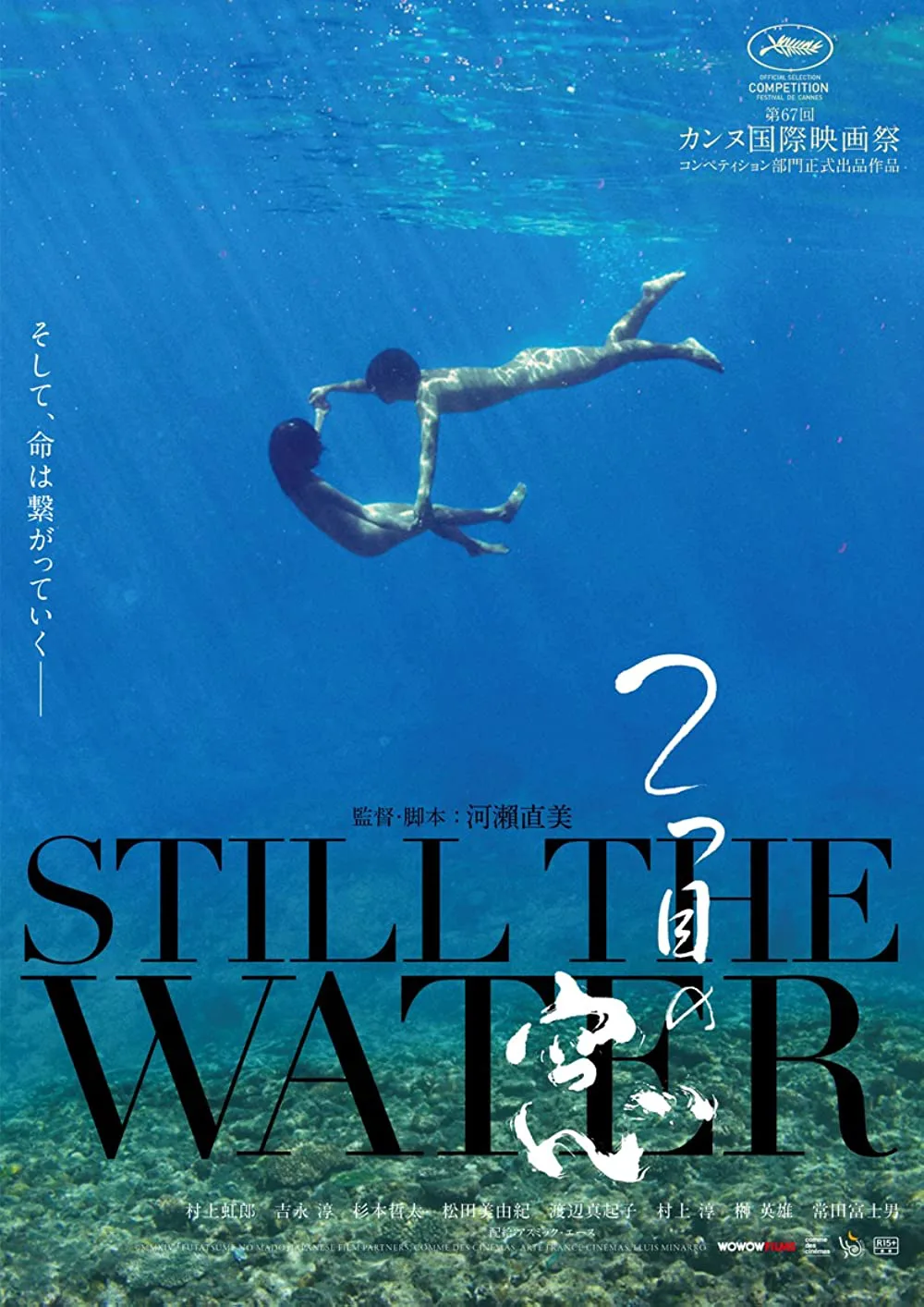Unveiled at Cannes nine years ago but not released theatrically until now, writer/director Naomi Kawase’s drama “Still the Water” is a coming-of-age story that sets its main characters, two ordinary teenagers, against a series of epic backdrops.
It begins on the island of Amami-Oshima and eventually returns there after a brief trip to Tokyo. The two main characters are Kaito (Nijirô Murakami) and Kyoko (Jun Yoshinaga, also known as Junko Abe). At first, the movie seems as if it’s going to be a murder mystery: Kaito and Kyoto make plans to meet at night near a seawall in their coastal village, but Kaito leaves after he sees a man’s body floating in the water. Police seal off the beach as they investigate whether the death was a murder or a suicide. But that doesn’t stop the free-spirited Kyoto from diving into the water fully clothed in her school uniform and swimming around reefs.
The film is not interested in what happened to the dead man because, for its purposes, the cause of death doesn’t matter. But death and life do matter very much: Kyoto’s kind and beautiful mother, Isa (Miyuki Matsuda), a local shaman, is being treated for a terminal illness that seems like it might be cancer, although the movie doesn’t specify. In a long conversation between Kyoto and Isa at her mother’s bedside that’s the film’s closest equivalent to a skeleton key unlocking artistic intent, a shaman is described as a spiritual leader who stands on the precipice between life and death, observable reality and the unknown, and can see in both directions, and carries a great burden because of it. This is a movie that casts a shaman’s eye on everything.
Much of the film is a series of ragged and organic-seeming conversations between Kaito, Kyoto, and other characters, as well as between the characters and the world—a cinematic dialogue that is expressed with shots and cuts, moving between the humans speaking with each other and the water, the trees, the sand, the sky, and so on. The characters are teens with powerful emotions who don’t understand much and lack wisdom. The film seems to have been calibrated to reflect their halting but sincere searches for meaning within experiences that they fear are ultimately meaningless or random. One discussion between them asks why people are born, live, and then die. Kyoto wants to know because her mother has just gotten a terminal diagnosis, and Kaito says he doesn’t have the answer but naively reassures his girlfriend that her mother can’t die because she’s a shaman.
Beyond the two leads, the characterizations are fractured, as in a Terrence Malick movie that gives us just as much of a person as it thinks a scene needs but doesn’t feel the urge to check in on everyone periodically so that you know they’re still involved in the story. Kaito is what used to be called a latchkey kid: he lives with his single mother, Misaki (Makiko Watanabe), a restaurant worker, and doesn’t see that much of her because she’s on the job so much. He visits his tattoo artist father, Atsushi (Jun Murakami), in Tokyo, seeking some explanation for why his parents split up; his father doesn’t have a good explanation for that, either, but reassures Kaito that it doesn’t affect his love for him, and somewhat unconvincingly says that he feels closer to Kaito’s mother now that they’re apart. The scene glancingly mirrors the scenes of Kyoko worrying about her mother’s health and contemplating the ultimate separation; her mom tells her that even after death, people continue to be present in the lives of people they love.
“Still the Water” begins with an off-putting image of an old fisherman named Kamejiro (Fujio Tokita) slitting a goat’s throat and hanging it up to bleed out—something that happens regularly all over the meat-eating world, but that people don’t generally like to see, certainly not in movies, and that had to be recut after the film’s premiere in accordance with the Cinematograph Animals Act—but that gory opening and the discovery of the body in the water (presumably not a real person) are the only scenes that have a confrontational edge.
This is mostly a gentle, quiet, intimate but big-seeming film in a mode that I’ve called “sensualist,” because it pays as much attention to the rhythm, color, and sound of the world surrounding the characters as it does to their stories, prizes mood and feeling over plot, and moves according to its own mysterious, often seemingly counterintuitive instincts. Wong Kar-Wai (“In the Mood for Love“) and Malick (“The Tree of Life“) are two directors who work in this mode. Viewers who commit to “Still the Water” and see it all the way through to the end may be reminded of them, and not just because Kawase and her cinematographer Yutaka Yamazaki often begin and end scenes with shots of ocean waves crashing, palm fronds rustling, and (in a city sequence) streets and skyscrapers lit up at night. Sometimes the filmmakers cut away to the wider world while someone is speaking, reminding us that just because they think their story is the center of the universe doesn’t make it so.
As a documentarian, Kawase has always worked in this style, although earlier films like “Uzaku” (1997), “Shara” (2003), and “The Mourning Forest” (2007) are tighter. “Still the Water” was initially characterized as a near-disaster for its director, although she’s gone on to make four more features and direct the official film representing the 2020 Tokyo Olympic Games. Her movies are of a sort that tends to be described as “meditative” by people who like them and “slow” or ‘boring” by people who don’t. The word “soporific” shows up in reviews often enough that you might wonder if somebody circulated a memo before the release date.
Nevertheless, “Still the Water” knows what it is and what it’s doing, and even if it doesn’t quite come together in the end, it’s a mistake to think that there’s no point or plan just because the movie doesn’t regularly announce its intentions. There’s no denying that the film is a bit scattered and not completely coherent. It requires a different kind of attentiveness than narrative features normally ask.
But the request is not unprecedented: the style is squarely within what’s now called “slow cinema,” and doesn’t feel hugely different from a classic like “Hiroshima, Mon Amour,” or even more recent efforts like Malick’s “To the Wonder” and Sofia Coppola’s “Somewhere.” Those films also feature characters moving through immense, gorgeous, real-world backdrops, examining their feelings, expressing confusion about life, and posing big questions in plain language that detractors liken to greeting card sentiments or fortune cookie messages. But fans might call them “poetic” even when the characters’ words are not as eloquent as the images and sounds. If you’re in the right frame of mind, or if you simply like this sort of movie, the rewards are worth it.
Now available on VOD and digital platforms.




















